wool pets
Making Figures with Wool Roving and a Barbed Needle Laurie Sharp Photography by Kevin Sharp

 This book is dedicated to The Fab FourHazel, Merna, Coco, and Carmellamy sheep. They are a big part of my inspiration.
This book is dedicated to The Fab FourHazel, Merna, Coco, and Carmellamy sheep. They are a big part of my inspiration.
Copyright 2008, Text, Laurie Sharp
Photographs, Kevin Sharp All rights reserved. No part of this work covered by the copyrights hereon may be reproduced or used in any form or by any meansgraphic, electronic, or mechanical, including photocopying, recording, taping of information on storage and retrieval systemswithout the written permission of the publisher. Due to differing conditions, materials, and skill levels, the publisher and various manufacturers disclaim any liability for unsatisfactory results or injury due to improper use of tools, materials, or information in this publication. This paperback edition published 2010 First published in the United States of America by Creative Publishing international, Inc., a member of
Quayside Publishing Group
400 First Avenue North
Suite 300
Minneapolis, MN 55401
1-800-328-3895
www.creativepub.com ISBN-13: 978-1-58923-525-0
ISBN-10: 1-58923-525-8 Digital Edition: 978-1-61673-513-5 10 9 8 7 6 5 4 3 2 1 Library of Congress Cataloging-in-Publication Data
Sharp, Laurie.
Wool pets : making 20 figures with wool roving and a barbed needle / by Laurie Sharp ; photography by Kevin Sharp.
p. Felt work. 2. Felting. 3. 3.
Animals in art. I. Title.
TT849.5.S53 2008
746.0463--dc22 2008000495
CIP Copy Editor: Sarah Erdreich
Proofreader: Beth Baumgartel
Book Design and Layout: Judy Morgan
Cover Design: everlution design Printed in China 
contents


 Needle felting is my passion and through this book I will share it with you. Most likely, youve dabbled in knitting, sewing, quilting, or even clay or woodworking. The bottom line is you probably like to work with your hands. When Im doing a public demonstration, I often hear I dont need another complicated hobby or craft.
Needle felting is my passion and through this book I will share it with you. Most likely, youve dabbled in knitting, sewing, quilting, or even clay or woodworking. The bottom line is you probably like to work with your hands. When Im doing a public demonstration, I often hear I dont need another complicated hobby or craft.
But needle felting is different! All you need to get started is some wool, a barbed needle, and a foam pad. You will be amazed at what you can create. There are a few types of felting, with wet felting being the most common form. Wool fibers are separated by hand and placed in layers into the desired pattern. With the addition of hot soapy water and agitation, the result is a felted fabric. Another popular felting method is to knit with wool yarn and then once the project is completed, the item is thrown into the washing machine with hot soapy water to agitate and felt. Needle felting does not involve wetting the fibers.
There are a few types of felting, with wet felting being the most common form. Wool fibers are separated by hand and placed in layers into the desired pattern. With the addition of hot soapy water and agitation, the result is a felted fabric. Another popular felting method is to knit with wool yarn and then once the project is completed, the item is thrown into the washing machine with hot soapy water to agitate and felt. Needle felting does not involve wetting the fibers.
You simply mold and shape wool with a barbed needle. I was drawn to needle felting because I wanted more control working with wool and I wanted to make detailed figures and animals in three-dimensional forms. The felting needle was the key to my success. By using this tool, I was able to make all sorts of animals and characters with as much detail as I wanted. I especially enjoy needle felting because it doesnt involve any measuring, weighing, counting, cutting, or other obstacles to creativity. It is a free-form and liberating craft experience! In this book, I will share some needle-felting techniques that I have developed over the past few years.
The goal is to encourage you to try needle felting and explore the many ways you can play with it. Let your imagination soar! So without further ado, lets get started! .
materials

The Felting Needle
There are three basic types of industrial felt. Woven felt is wool or a blend of wool and other yarn that is woven into a cloth and then felted using steam and pressure to make the fibers interlock. Pressed felt is the oldest type of fabric known, predating weaving and knitting, and is produced simply by pressing fibers together and steaming to naturally interlock the fibers. The third type of industrial felt, needled felt, is produced by a machine that carries thousands of felting needles and moves up and down to mechanically interlock fibers.
The felting needle is a long, sharp, three- or five-sided barbed instrument. Sounds dangerous, eh? This needle is the tool used for sculptural needle felting. Felting needles come in a variety of gauges from fine (forty gauge) to coarse (thirty-eight gauge) and they vary in the number of sides on the bottom shaft (three to five). The sides of the needle have tiny barbs poking out. Some of the barbs are close together and some are further apart. I recommend starting with a thirty-eight-gauge triangular (three-sided) needle.
This size is considered standard. The projects in this book only require using one needle at a time. There are needle holders available that can hold two to sixteen needles at a time. The needle holders have a handle that unscrews so you can put the needles in and remove them. This tool is good if you want to make a large sculpture or large flat piece of felt. Store your needle in a safe place when you are not using it.
I usually poke my needle deep into the side of a foam pad. Take care not to bend the needles. They are strong but brittle and they will break when bent. It goes without saying, try not to poke yourself while working. Watch your hands while you work.
Foam
You will need to have a piece of foam or sponge to absorb the needle when it penetrates through the wool.
The best surface to use for needle felting is high-density foam that is at least 1 (3.8 cm) thick. Place the wool on the pad and keep needling without worrying about poking your leg or breaking your needle. Some craft stores sell upholstery foam, which can be used in a pinch, but it breaks down faster than the high-density foam. 
 Clockwise from upper left: (A) wool combs, (B) metal two-needle holder, (C) wooden skewers for shaping wool, (D) foam, (E) embroidery scissors, (F) sewing needle for adding details, (G) felting needles (see close-up at left), (H) wooden five-needle holder
Clockwise from upper left: (A) wool combs, (B) metal two-needle holder, (C) wooden skewers for shaping wool, (D) foam, (E) embroidery scissors, (F) sewing needle for adding details, (G) felting needles (see close-up at left), (H) wooden five-needle holder
Wool
Almost any fiber can be needledyour hair, your kittys hair, dog hair, mohair, llama, and alpaca fiber. I find that sheeps wool is the absolute best thing to use for needle felting. Why? Because sheep are cute.
No, not really. Wool fiber has scales on it. When you poke the felting needle into the wool, the barbs on the sides of the needle make contact with the scales on the wool and cause them to tangle together. In essence, that is felt-making. The more you poke, the more compact the wool fiber becomes. This is where the magic begins....


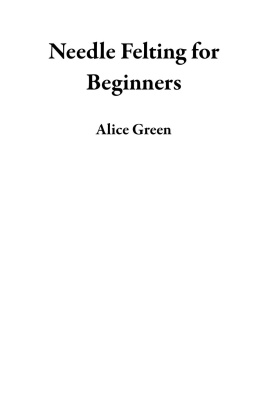
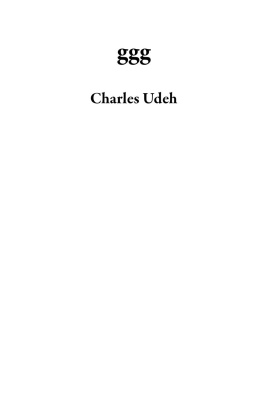
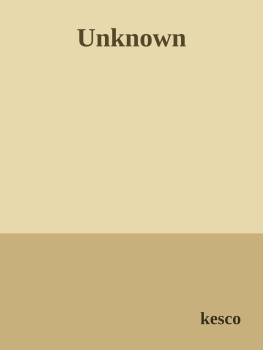

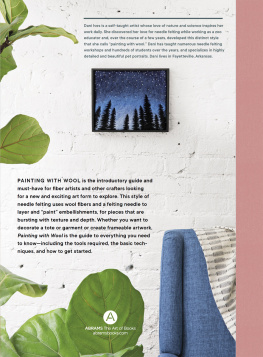
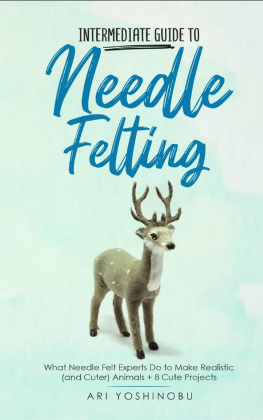

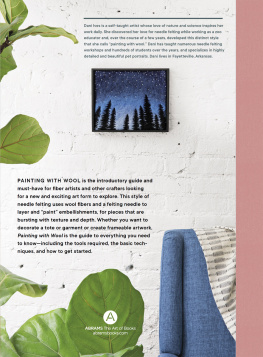
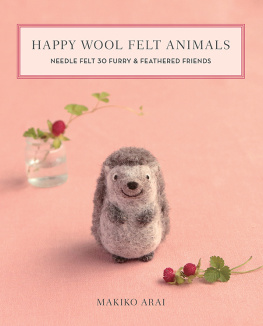

 This book is dedicated to The Fab FourHazel, Merna, Coco, and Carmellamy sheep. They are a big part of my inspiration.
This book is dedicated to The Fab FourHazel, Merna, Coco, and Carmellamy sheep. They are a big part of my inspiration. Copyright 2008, Text, Laurie Sharp
Copyright 2008, Text, Laurie Sharp


 Needle felting is my passion and through this book I will share it with you. Most likely, youve dabbled in knitting, sewing, quilting, or even clay or woodworking. The bottom line is you probably like to work with your hands. When Im doing a public demonstration, I often hear I dont need another complicated hobby or craft.
Needle felting is my passion and through this book I will share it with you. Most likely, youve dabbled in knitting, sewing, quilting, or even clay or woodworking. The bottom line is you probably like to work with your hands. When Im doing a public demonstration, I often hear I dont need another complicated hobby or craft. There are a few types of felting, with wet felting being the most common form. Wool fibers are separated by hand and placed in layers into the desired pattern. With the addition of hot soapy water and agitation, the result is a felted fabric. Another popular felting method is to knit with wool yarn and then once the project is completed, the item is thrown into the washing machine with hot soapy water to agitate and felt. Needle felting does not involve wetting the fibers.
There are a few types of felting, with wet felting being the most common form. Wool fibers are separated by hand and placed in layers into the desired pattern. With the addition of hot soapy water and agitation, the result is a felted fabric. Another popular felting method is to knit with wool yarn and then once the project is completed, the item is thrown into the washing machine with hot soapy water to agitate and felt. Needle felting does not involve wetting the fibers.

 Clockwise from upper left: (A) wool combs, (B) metal two-needle holder, (C) wooden skewers for shaping wool, (D) foam, (E) embroidery scissors, (F) sewing needle for adding details, (G) felting needles (see close-up at left), (H) wooden five-needle holder
Clockwise from upper left: (A) wool combs, (B) metal two-needle holder, (C) wooden skewers for shaping wool, (D) foam, (E) embroidery scissors, (F) sewing needle for adding details, (G) felting needles (see close-up at left), (H) wooden five-needle holder